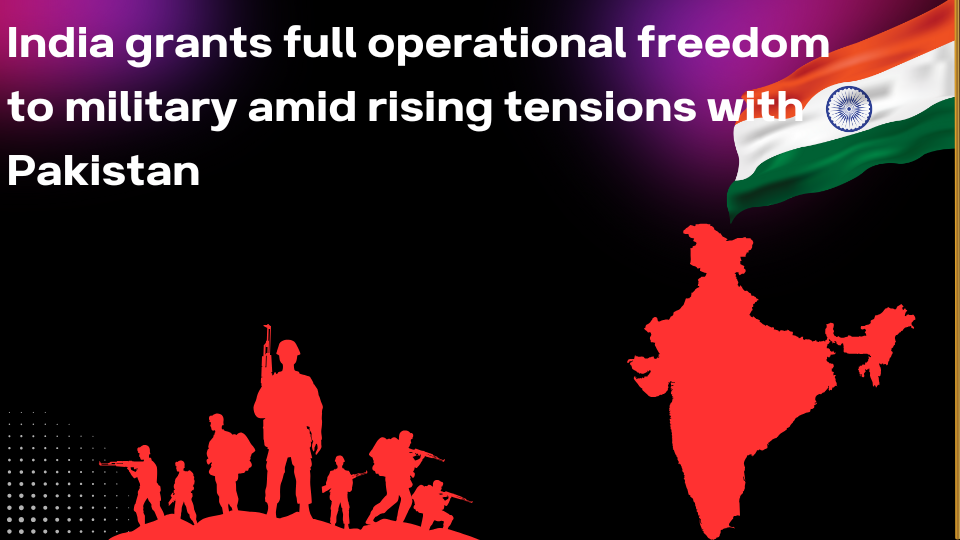In a significant strategic move, Prime Minister Narendra Modi has granted the Indian Armed Forces “full operational freedom” to respond to security threats without prior government clearance. The decision comes amid escalating tensions with Pakistan, whose Defense Minister Khawaja Asif recently claimed that war between the two nuclear-armed neighbors could erupt within “two to four days.
Key points

Operational freedom: What it means
The new directive empowers India’s military to independently decide the timing, scale, and nature of retaliatory actions against cross-border aggression. Previously, such decisions required political approval. The move signals a shift toward a more proactive stance, particularly after repeated ceasefire violations by Pakistan along the Line of Control (LoC).
Defense analysts suggest the policy aims to deter Pakistan-backed terrorism while allowing swift responses to provocations. “This is a clear message that India will no longer tolerate proxy wars or unilateral aggression,” said a senior military official.
The decision of full operational freedom came after high level security meeting
The decision came after a high-level security meeting chaired by PM Modi, attended by Defense Minister Rajnath Singh, National Security Advisor Ajit Doval, Chief of Defense Staff General Anil Chauhan, and the chiefs of the Army, Navy, and Air Force. The meeting reviewed the security situation after the Poonch attack, where five Indian soldiers were killed in an ambush by suspected Pakistan-backed terrorists.
Sources indicate that the armed forces have been given a free hand to decide the mode, timing, and targets of retaliation. This includes options like surgical strikes, airstrikes, drone attacks, special forces operations, or cyber warfare without requiring prior political clearance for each action.
Pakistan’s alarming rhetoric
Pakistan’s Defense Minister Khawaja Asif stoked fears of conflict by alleging that India might initiate hostilities before upcoming elections in Bihar later this year a claim Indian officials dismissed as baseless. “There is no major election in India until November 2025. Pakistan is peddling misinformation to justify its own aggressive posturing,” said a government spokesperson.
Adding to the tensions, Pakistani leaders have repeatedly referenced nuclear weapons in their warnings to India. However, former Prime Minister Nawaz Sharif reportedly advised his brother, current PM Shehbaz Sharif, to pursue diplomacy instead of escalation a suggestion seemingly ignored as cross-border skirmishes continue.
Global concerns and economic fallout
The rising tensions have alarmed international observers, with Asian markets closely monitoring the situation. India’s stock market, the world’s fifth-largest, faces volatility as investors weigh the risk of conflict. In contrast, Pakistan’s economy, already in crisis, remains isolated except for Chinese investments.
Experts warn that any large-scale Indian military action such as strikes on terror camps in Pakistan-Occupied Kashmir (PoK) could trigger a broader confrontation if Pakistan retaliates. “The world is watching whether Pakistan downplays the damage, as it did after Balakot, or acknowledges losses, which would force a response,” said a geopolitical analyst.
Diplomatic and Strategic Moves
Amid the standoff, India has engaged with Taliban-led Afghanistan, raising speculation about coordinated pressure on Pakistan from multiple fronts. Meanwhile, Pakistan alleges that militants are attempting to infiltrate its border from Afghanistan, further complicating regional stability.
India has also banned several Pakistani propaganda channels for spreading disinformation, a move hailed by security experts. “Pakistan’s media ecosystem thrives on anti-India narratives. Cutting off these channels is crucial to countering fake news,” said a senior official.
Public sentiment and military options
With public opinion favoring a strong response, speculation is rife that India might reclaim strategic areas in PoK, mirroring past successes like the Siachen Glacier operation. “If Pakistan abandons the Shimla Agreement, India has every right to redefine the LoC,” said a retired general.
As both nations brace for potential conflict, the international community urges restraint. For now, India’s military retains the autonomy to act but whether this deters Pakistan or escalates hostilities remains to be seen.
Possible military scenarios
- Surgical Strikes 2.0: Precision hits on terror launchpads in PoK.
- Balakot-Style Airstrikes: Deep penetration raids targeting terror infrastructure.
- Drone Warfare: Targeting terror safe houses with precision strikes.
- Cyber Operations: Disrupting Pakistan’s propaganda networks.
These types of incidents may takes place.
You should check:- Pahalgam terror attack
hi